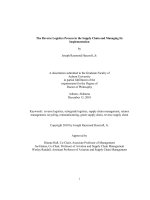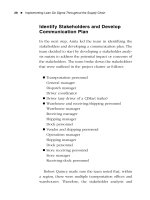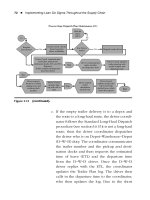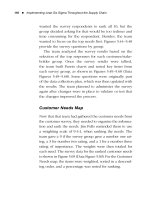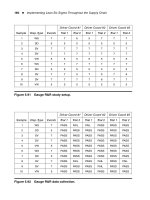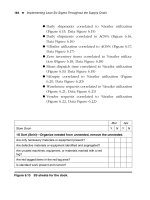Logistics management and strategy competing through the supply chain
Bạn đang xem bản rút gọn của tài liệu. Xem và tải ngay bản đầy đủ của tài liệu tại đây (5.24 MB, 343 trang )
Competing through the supply chain
3rd edition
Alan Harrison and Remko van Hoek
A concise, applied and strategic introduction to the subject of logistics and supply chain management, perfect
for modern managers and students of logistics and supply chain management.
Logistics and supply chain management continue to transform the competitive landscape and have become
one of today’s key business issues. This third edition of Logistics Management and Strategy continues to take a
practical, integrated and international approach to logistics and includes the very latest research to reflect the
innovative and exciting developments in this subject area.
A clear framework guides the reader through the four parts of the book, covering:
l an introduction to logistics and its contribution to competitiveness and value creation,
l leveraging logistics operations within the context of the customer,
l supplier partnerships, interfaces and the challenges of integration,
l leading-edge thinking in logistics and the future challenges ahead.
Every chapter features case studies with study questions, activities and end of chapter discussion questions
to help students explore logistical concepts in operational detail. Teaching support notes and PowerPoint
slides for lecturers can be downloaded from the book’s website at www.pearsoned.co.uk/harrison
‘Well written and contains a wealth of valuable ideas and concepts.’
Dr Jan de Vries, University of Groningen
‘Very up-to-date, both in terms of its conceptual framework and
the topics covered. Remarkably clear and easy to read.’
Dr Tony Whiteing, University of Huddersfield
Alan Harrison is Professor of Operations and Logistics at Cranfield School of Management, and Director of
Research at The Cranfield Centre for Logistics and Supply Chain Management.
Logistics Management
and Strategy
Competing through the supply chain
3rd edition
3rd
edition
Harrison and van Hoek
New to this edition…
l more on reverse logistics together with green, ethical and CSR issues,
l revised chapters on supply chain planning and control and on agility,
l fully revised final chapter ties in the future challenges facing logistics more closely
with the rest of the book.
Logistics Management
and Strategy
Logistics Management and Strategy
Remko van Hoek is Professor of Supply Chain Management at The Cranfield Centre for Logistics and Supply
Chain Management. He is also Vice President Procurement at Nuon in the Netherlands.
www.pearson-books.com
9780273712763_03_COVER.indd 1
Alan Harrison and
Remko van Hoek
18/10/07 13:56:29
LOGI_A01.QXP
3/17/08
9:35 AM
Page i
Logistics Management
and Strategy
Competing through the supply chain
LOGI_A01.QXP
3/17/08
9:35 AM
Page ii
We work with leading authors to develop the
strongest educational materials in logistics,
bringing cutting-edge thinking and best
learning practice to a global market.
Under a range of well-known imprints, including
Financial Times Prentice Hall, we craft high quality print and
electronic publications which help readers to understand
and apply their content, whether studying or at work.
To find out more about the complete range of our
publishing, please visit us on the World Wide Web at:
www.pearsoned.co.uk
LOGI_A01.QXP
3/17/08
9:35 AM
Page iii
Logistics Management
and Strategy
Competing through the supply chain
Third Edition
Alan Harrison
Remko van Hoek
LOGI_A01.QXP
3/17/08
9:35 AM
Page iv
Pearson Education Limited
Edinburgh Gate
Harlow
Essex CM20 2JE
England
and Associated Companies throughout the world
Visit us on the World Wide Web at:
www.pearsoned.co.uk
First published 2002
Second edition published 2005
Third edition published 2008
© Pearson Education Limited 2002, 2005
© Alan Harrison and Remko van Hoek 2008
The rights of Alan Harrison and Remko van Hoek to be identified as authors
of this work have been asserted by them in accordance with the Copyright,
Designs and Patents Act 1988.
All rights reserved. No part of this publication may be reproduced, stored in
a retrieval system, or transmitted in any form or by any means, electronic,
mechanical, photocopying, recording or otherwise, without either the prior
written permission of the publisher or a licence permitting restricted copying
in the United Kingdom issued by the Copyright Licensing Agency Ltd,
Saffron House, 6–10 Kirby Street, London EC1N 8TS.
All trademarks used herein are the property of their respective owners. The use of
any trademark in this text does not vest in the author or publisher any trademark
ownership rights in such trademarks, nor does the use of such trademarks imply any
affliliation with or endorsement of this book by such owners.
ISBN: 978-0-273-71276-3
British Library Cataloguing-in-Publication Data
A catalogue record for this book is available from the British Library
Library of Congress Cataloging-in-Publication Data
Harrison, Alan, 1944–
Logistics management and strategy : competing through the supply chain / Alan Harrison,
Remko van Hoek.— 3rd ed.
p. cm.
Includes bibliographical references and index.
ISBN-13: 978-0-273-71276-3 (pbk. : alk. paper) 1. Business logistics. 2. Industrial
management. I. Hoek, Remko I. van. II. Title.
HD38.5.H367 2008
658.5—dc22
2007046447
10 9 8 7 6 5 4 3 2
11 10 09 08
Typeset in 9.5pt Stone Sans by 3
Printed and bound in Malaysia
The publisher’s policy is to use paper manufactured from sustainable forests.
LOGI_A01.QXP
3/17/08
9:35 AM
Page v
To Nick, Katie, Maryl and Ticho, with love.
LOGI_A01.QXP
3/17/08
9:35 AM
Page vi
LOGI_A01.QXP
3/17/08
9:35 AM
Page vii
Contents
Foreword
Preface
Author’s acknowledgements
Publisher’s acknowledgements
How to use this book
Plan of the book
xv
xvii
xix
xx
xxiii
xxv
Part One COMPETING THROUGH LOGISTICS
1 Logistics and the supply chain
Introduction
1.1 Logistics and the supply chain
1.1.1 Definitions and concepts
1.1.2 Supply chain: structure and tiering
1.2 Material flow and information flow
1.2.1 Material flow
1.2.2 Information flow
1.3 Competing through logistics
1.3.1 Hard objectives
1.3.2 Supportive capabilities
1.3.3 Soft objectives
1.3.4 Order winners and qualifiers
1.4 Logistics strategy
1.4.1 Defining ‘strategy’
1.4.2 Aligning strategies
1.4.3 Differentiating strategies
Summary
Discussion questions
References
Suggested further reading
2 Putting the end-customer first
Introduction
2.1 The marketing perspective
2.1.1 Rising customer expectations
2.1.2 The information revolution
2.2 Segmentation
2.3 Quality of service
2.3.1 Customer loyalty
3
3
4
6
8
12
12
14
15
16
18
22
23
25
26
27
28
30
31
31
32
33
33
34
35
35
36
44
45
LOGI_A01.QXP
viii
3/17/08
9:35 AM
Page viii
Contents
2.3.2 Value disciplines
2.3.3 Customer relationship management (CRM)
2.3.4 Measuring service quality
2.4 Setting priorities for logistics strategy
2.4.1 Step 1: Diagnose current approach to market segmentation
2.4.2 Step 2a: Understand buying behaviour
2.4.3 Step 2b: Customer value analysis
2.4.4 Step 3: Measure logistics strategy driver
2.4.5 Step 4: Specify future approach to market segmentation
Summary
Discussion questions
References
Suggested further reading
3 Value and logistics costs
Introduction
3.1 Where does value come from?
3.1.1 Return on investment (ROI)
3.1.2 Financial ratios and ROI drivers
3.2 How can logistics costs be represented?
3.2.1 Fixed/variable
3.2.2 Direct/indirect
3.2.3 Engineered/discretionary
3.3 Activity-based costing (ABC)
3.3.1 ABC example
3.3.2 Cost–time profile (CTP)
3.4 A balanced measurement portfolio
3.4.1 Balanced measures
3.4.2 Supply chain management and the balanced scorecard
3.4.3 Supply chain financial model
3.5 Supply chain operations reference model (SCOR)
Summary
Discussion questions
References
46
47
50
50
50
52
53
54
54
57
58
63
64
65
65
66
67
69
71
71
76
78
81
82
83
85
86
87
88
89
93
94
95
Part Two LEVERAGING LOGISTICS OPERATIONS
4 Managing logistics internationally
Introduction
4.1 Drivers
4.1.1
4.1.2
4.1.3
4.1.4
and logistics implications of internationalisation
Logistical implications of internationalisation
Time-to-market
Global consolidation
Risk in international logistics
99
99
101
102
105
106
109
LOGI_A01.QXP
3/17/08
9:35 AM
Page ix
Contents
4.2
The tendency towards internationalisation
4.2.1 Focused factories: from geographical to product
segmentation
4.2.2 Centralised inventories
4.3 The challenges of international logistics and location
4.3.1 Extended lead time of supply
4.3.2 Extended and unreliable transit times
4.3.3 Multiple consolidation and break points
4.3.4 Multiple freight modes and cost options
4.3.5 Location analysis
4.4 Organising for international logistics
4.4.1 Layering and tiering
4.4.2 The evolving role of individual plants
4.4.3 Reconfiguration processes
4.5 Reverse logistics
4.6 Managing for risk readiness
4.6.1 Immediate risk readiness
4.6.2 Structural risk readiness
4.7 Corporate social responsibility in the supply chain
Summary
Discussion questions
References
Suggested further reading
5 Managing the lead-time frontier
Introduction
5.1 The role of time in competitive advantage
5.1.1 Time-based competition: definition and concepts
5.1.2 Time-based initiatives
5.1.3 Time-based opportunities to add value
5.1.4 Time-based opportunities to reduce cost
5.1.5 Limitations to time-based approaches
5.2 P:D ratios and differences
5.2.1 Using time as a performance measure
5.2.2 Using time to measure supply pipeline performance
5.2.3 Consequences when P-time is greater than D-time
5.3 Time-based process mapping
5.3.1 Stage 1: Create a task force
5.3.2 Stage 2: Select the process to map
5.3.3 Stage 3: Collect data
5.3.4 Stage 4: Flow chart the process
5.3.5 Stage 5: Distinguish between value-adding and
non-value-adding time
5.3.6 Stage 6: Construct the time-based process map
5.3.7 Stage 7: Solution generation
ix
111
111
112
115
116
116
116
117
118
120
120
121
122
129
130
130
131
132
136
137
137
137
139
139
140
140
141
141
144
146
146
147
148
150
153
154
154
155
155
155
156
156
LOGI_A01.QXP
x
3/17/08
9:35 AM
Page x
Contents
5.4
Managing timeliness in the logistics pipeline
5.4.1 Strategies to cope when P-time is greater than D-time
5.4.2 Practices to cope when P-time is greater than D-time
5.5 A method for implementing time-based practices
5.5.1 Step 1: Understand your need to change
5.5.2 Step 2: Understand your processes
5.5.3 Step 3: Identify unnecessary process steps and large
amounts of wasted time
5.5.4 Step 4: Understand the causes of waste
5.5.5 Step 5: Change the process
5.5.6 Step 6: Review changes
5.5.7 Results
5.6 When, where and how?
Summary
Discussion questions
References
Suggested further reading
6 Supply chain planning and control
Introduction
6.1 The supply chain ‘game plan’
6.1.1 Planning and control within the focal firm
6.1.2 Managing inventory in the supply chain
6.1.3 Inter-firm planning and control
6.2 Just-in-time (JIT)
6.2.1 The just-in-time system
6.2.2 JIT and material requirements planning (MRP)
6.3 Lean thinking
6.3.1 The seven wastes
6.3.2 Application of lean thinking to business processes
6.3.3 Role of lean practices
6.3.4 Design strategies
6.3.5 Lean product design
6.3.6 Lean facility design
6.3.7 Lean thinking summary
Summary
Discussion questions
References
Suggested further reading
7 The agile supply chain
Introduction
7.1 The concept of agility
7.1.1 Demand characteristics and supply capabilities
7.1.2 Classifying operating environments
161
162
163
164
165
165
166
166
166
166
167
167
168
169
169
169
171
171
173
173
177
181
184
185
190
192
194
195
196
197
197
197
198
198
199
200
201
203
203
204
206
214
LOGI_A01.QXP
3/17/08
9:35 AM
Page xi
Contents
7.1.3 Preconditions for successful agile practice
7.1.4 Summary
7.2 Agile drivers and practices
7.2.1 Joint decision making to improve external network
integration
7.2.2 Developing measures to put the end-customer first
7.2.3 Shared goals to improve virtual integration
7.2.4 Boundary-spanning SOP to improve process integration
Summary
Discussion questions
References
Suggested further reading
xi
214
219
219
222
223
224
225
226
227
228
229
Part Three WORKING TOGETHER
8 Integrating the supply chain
Introduction
8.1 Integration in the supply chain
8.1.1 Internal integration: function to function
8.1.2 Inter-company integration: a manual approach
8.1.3 Electronic integration
8.2 Efficient consumer response (ECR)
8.2.1 Category management
8.2.2 Continuous replenishment
8.2.3 Enabling technologies
8.3 Collaborative planning, forecasting and replenishment (CPFR)
8.3.1 Benefits of electronic collaboration
8.4 Vendor-managed inventory (VMI)
8.4.1 How VMI works
8.4.2 Potential benefits
8.4.3 Potential problems in setting up a VMI system
8.5 Quick response (QR)
8.5.1 JIT/QR relationship
8.5.2 Role of enabling technologies
8.6 Managing supply chain relationships
8.6.1 Creating closer relationships
8.6.2 Factors in forming supply chain relationships
Summary
Discussion questions
References
Suggested further reading
9 Purchasing and supply relationships
Introduction
233
233
234
235
237
238
242
243
243
244
248
252
252
253
253
254
255
256
256
257
257
258
260
261
262
263
265
265
LOGI_A01.QXP
xii
3/17/08
9:35 AM
Page xii
Contents
9.1
9.2
Choosing the right supply relationships
Partnerships in the supply chain
9.2.1 Economic justification for partnerships
9.2.2 Advantages of partnerships
9.2.3 Disadvantages of partnerships
9.3 Supply base rationalisation
9.3.1 Supplier management
9.3.2 Lead suppliers
9.4 Supplier networks
9.4.1 Supplier associations
9.4.2 Japanese keiretsu
9.4.3 Italian districts
9.5 Supplier development
9.5.1 Integrated processes
9.5.2 Synchronous production
9.6 Implementing strategic partnerships
Summary
Discussion questions
References
Suggested further reading
266
274
274
274
275
275
276
276
277
277
280
281
284
285
285
286
290
291
292
293
Part Four CHANGING THE FUTURE
10 Logistics future challenges and opportunities
Introduction
10.1 Internal alignment
10.2 Selecting collaborative opportunities upstream and downstream
10.3 Managing with cost-to-serve to support growth and profitability
10.4 The supply chain manager of the future
Summary
Discussion questions
References
Suggested further reading
Index
297
297
298
302
305
308
310
310
310
310
311
LOGI_A01.QXP
3/17/08
9:35 AM
Page xiii
Supporting resources
Visit www.pearsoned.co.uk/harrison to find valuable online resources
For instructors
• Complete, downloadable Instructor’s Manual, containing teaching notes,
notes on case studies and teaching tips, objectives and discussion points for
each chapter
• Downloadable PowerPoint slides of all figures from the book
For more information please contact your local Pearson Education sales
representative or visit www.pearsoned.co.uk/harrison
LOGI_A01.QXP
3/17/08
9:35 AM
Page xiv
LOGI_A01.QXP
3/17/08
9:35 AM
Page xv
Foreword
It is a real pleasure to introduce such a quality text as Logistics Management and
Strategy, now in its third edition, which helps to enhance our understanding of
this important area of business today. It is a field that is rapidly gaining importance and focus as businesses like Reckitt Benckiser address the challenge of meeting increasingly demanding customer expectations in all five continents.
Reckitt Benckiser is rightly famous for the excellence of its products – but product
excellence must be supported by logistics excellence so that a broad range is always
available for the end-consumer to buy. One challenge is obviously to ensure this availability to the consumer while complying with the requirements of trade customers.
Another challenge is to achieve all of this at a low cost in order to be able to offer products to the consumer at reasonable prices. Answering these challenges is the aim of
the Reckitt Benckiser network and, more specifically, of our logistics organisation.
At Reckitt Benckiser we describe ourselves as a ‘truly global company passionately delivering better solutions to consumers, with operations in 60 countries,
sales in 180 countries and net revenues in excess of £5 billion’.
The logistics task in fulfilling our objective, with such a business scope, is
immense. We have 44 factories around the world and produce several hundreds
of different products from food to home and personal care.
We have grown by over 70% over the last five years, which poses further challenges for our logistics systems and people to meet. On the one hand, we need to
optimise our systems and minimise costs; on the other hand, we must support
the growth of the business and ensure product and process innovation. For us to
succeed, it is becoming increasingly important to excel in the management of
logistics, which becomes a strategic function and a source of differentiation and
of competitive advantage. This means that managers in all parts of the business
must understand their impact on, and role in, the logistics task.
Logistics Management and Strategy is an excellent text that supports the need to disseminate knowledge and understanding of logistics in an easy-to-read way. While
explaining with great clarity the theoretical concepts, it remains very pragmatic and
close to business life through the use of concrete examples and well-chosen case
studies. It manages to examine logistics knowledge and understanding in depth
while at the same time remaining not only very accessible but really pleasant to read.
Finally, its international perspective reflects the nature of logistics today in
businesses like Reckitt Benckiser. As another Anglo-Dutch collaboration, Alan
and Remko have succeeded in helping to increase our understanding of a rapidly
evolving and increasingly crucial area of doing business in the twenty-first
century.
Alain Le Goff
Executive Vice President, Global Supply
Member of the Executive Committee
Reckitt Benckiser
LOGI_A01.QXP
3/17/08
9:35 AM
Page xvi
LOGI_A01.QXP
3/17/08
9:35 AM
Page xvii
Preface
Logistics has been emerging from Peter Drucker’s shadowy description as ‘the economy’s dark continent’ for some years.1 From its largely military origins, logistics
has accelerated into becoming one of the key business issues of the day, presenting
formidable challenges for managers and occupying some of the best minds. Its relatively slow route to this exalted position can be attributed to two causes. First,
logistics is a cross-functional subject. In the past, it has rightly drawn on contributions from marketing, finance, operations and corporate strategy. Within the
organisation, a more appropriate description would be a business process, cutting
across functional boundaries yet with a contribution from each. Second, logistics
extends beyond the boundaries of the organisation into the supply chain. Here, it
engages with the complexities of synchronising the movement of materials and
information between many business processes. The systems nature of logistics has
proved a particularly difficult lesson to learn, and individual organisations still
often think that they can optimise profit conditions for themselves by exploiting
their partners in the supply chain. Often they can – in the short term. But winners
in one area are matched by losers in another, and the losers are unable to invest or
to develop the capabilities needed to keep the chain healthy in the long term. The
emergence of logistics has therefore been dependent on the development of a
cross-functional model of the organisation, and on an understanding of the need
to integrate business processes across the supply network.
While its maturity as a discipline in its own right is still far from complete, we
believe that it is time to take a current and fresh look at logistics management
and strategy. Tools and concepts to enable integration of the supply chain are
starting to work well. Competitive advantage in tomorrow’s world will come
from responding to end-customers better than the competition. Logistics plays a
vital role in this response, and it is this role that we seek to describe in this book.
This text has a clear European appeal. Its currency is the Euro. But in line with
the globalisation of logistics, we have included cases from other parts of the
world, including South Africa, the United States, Japan, China and Australia.
Accordingly, we start in Part One with the competitive role of logistics in the
supply chain. We continue by developing the marketing perspective by explaining our view of ‘putting the end-customer first’. Part One finishes by exploring
the concept of value and logistics costs. In Part Two, we review leveraging logistics operations in terms of their global dimensions, and of the lead-time frontier.
Part Two continues by examining the impact on logistics of lean thinking and
the agile supply chain. Part Three reviews working together, first in terms of integrating the supply chain and second in terms of partnerships. Our book ends
with Part Four, in which we outline the logistics future challenge.
This text is intended for MSc students on logistics courses, and as an accompanying text for open learning courses such as the global MSc degrees and virtual
1 Drucker, P. (1962) ‘The economy’s dark continent’, Fortune, April, pp. 103–270.
LOGI_A01.QXP
xviii
3/17/08
9:35 AM
Page xviii
Preface
universities. It will also be attractive as a management textbook and as recommended reading on MBA options in logistics and supply chain management.
In the second edition, we listened carefully to students and to reviewers alike
and set out to build on the foundation of our initial offering. We updated much
of the material while keeping the clear structure and presentation of the first
edition. We included lots of new cases and updated others. We attempted to
touch on many of the exciting developments in this rapidly expanding body of
knowledge, such as governance councils, the prospects for RFID and the future of
exchanges.
Since we launched this textbook in 2001, it has become a European best-seller
– and is popular in Australia, Singapore and South Africa. It has also been
launched in Japan, Brazil, China and the Ukraine. The third edition retains the
clarity and up-to-date content which have become hallmarks of the previous
editions. This edition continues to provide further new and updated cases to
illustrate developments in the subject. This time, chapters 6, 7 and 10 have been
largely reconstructed, but you will also find many improvements to other chapters resulting from our research and our work with industrial partners. To formalise the connection between logistics and the supply chain, we have added the
subtitle ‘Competing through the supply chain’.
We hope that our book will offer support to further professional development
in logistics and supply chain management, which is much needed. In particular,
we hope that it encourages you to challenge existing thinking, and to break old
mindsets by creating a new and more innovative future.
LOGI_A01.QXP
3/17/08
9:35 AM
Page xix
Author’s acknowledgements
We should like to acknowledge our many friends and colleagues who have contributed to our thinking and to our book. Cranfield colleagues deserve a special
mention: Dr Paul Chapman, Janet Godsell, Dr Carlos Mena, Simon Templar and
Professor Richard Wilding have been particularly helpful. Sri Srikanthan helped
us with the financial concepts used in section 3.2. Members of the Agile Supply
Chain Research Club at Cranfield also deserve special mention, especially Chris
Poole of Procter & Gamble (now of PA Management Consultants), Paul Mayhew
of Bausch & Lomb Europe, Ian Shellard and David Evans of Rolls-Royce, Peter
Duggan of Telefonica and Colin Peacock of Procter & Gamble. We have picked
the brains of several who have recently retired from the industry, including
David Aldridge (formerly of Cussons UK), Philip Matthews (formerly of Boots the
Chemists) and Graham Sweet of Xerox, Europe. A number of professors from
other European universities have contributed ideas and cases, including Marie
Koulikoff-Souviron (CERAM, Nice), Jacques Colin (CretLog, Aix-en-Provence),
Konstantinos Zographos (Athens University of Economics and Business), and
Corrado Ceruti (University of Roma). Many of our MSc graduates, such as Steve
Walker and Alexander Oliveira, also made important contributions. Professor
Yemisi Bolumole (University of North Florida) helped us to re-draft earlier versions of the first edition, and Professor Martin Christopher contributed to our
earlier thinking on agile supply chains. Dr Jim Aitken contributed to our supply
chain segmentation thinking in Chapter 2, and we have used his work on supplier associations in Chapter 9. We also acknowledge the encouragement of
Amanda McPartlin at Pearson Education in the preparation of this text and the
encouragement to write it faster! Also, we thank the reviewers who made many
valuable comments on earlier editions of this book. We are very grateful to all of
these, and to the many others who made smaller contributions to making this
book possible. Finally, we thank Lynne Hudston for helping to sort out our rather
convoluted manuscripts in addition to helping to run our Supply Chain Research
Centre at Cranfield.
LOGI_A01.QXP
3/17/08
9:35 AM
Page xx
Publisher’s acknowledgements
We would like to thank the following reviewers for their valuable comments and
feedback on the book:
Des Doran – Kingston University, UK
Prasanta Kumar Dey – Aston University, UK
Arni Halldorsson – University of Southampton, UK
John Johansen – Aalborg University, Denmark
Paul Davis – Dublin City University, Eire
Mathew Shafaghi – University of Bolton, UK
We are grateful to the following for permission to reproduce copyright material:
Figure 1.6 from JIT in a distribution environment, International Journal of Logistics
Management, Vol. 9 No. 1, pp. 32–4 (Eggleton, D.J. 1990), Table 2.6 from Logistic
service measurement: a reference framework, Journal of Manufacturing Technology
Management, Vol. 15 No. 3, pp. 280–90 (Rafele, C. 2004), Figures 4.11–4.13 from
Reconfiguring the supply chain to implement postponed manufacturing,
International Journal of Logistics Management, Vol. 9 No. 1 (van Hoek, R.I. 1998),
Figures 8.9 and 9.9 from The pervasive human resource picture in interdependent
supply relationships, International Journal of Operations and Production Management,
Vol. 27 Nol. 1 (Koulikoff-Souviron, M. and Harrison, A. 2007), Figure 9.8 from An
empirical investigation into supply chain management: a perspective on partnerships, International Journal of Physical Distribution and Logistics Management, Vol. 28
No. 8 (Spekman, R.E., Kamauff Jr, J.W. and Myhr, N. 1998), reprinted by permission of Emerald Group Publishing Limited; Figure 1.7 from Strategic Supply Chain
Alignment (Gattorna, J., ed. 1998), © Ashgate Publishing Limited; Table 2.5 from
Strategy formulation in an FMCG supply chain, Proceedings of the EurOMA
Conference, Copenhagen (Godsell, J. and Harrison, A. 2002), reprinted by permission of Janet Godsell; Figure 2.3 from The impact of technology on the qualityvalue-loyalty chain: a research agenda, Journal of the Academy of Marketing
Science, Vol. 28 No. 1, pp. 168–74 (Parasuraman, A. and Grewal, D. 2000), copyright 2000 by Sage Publications, reprinted by permission of Sage Publications, Inc.;
Figures 2.6, 2.8 and 2.10 from Developing Supply Chain Strategy: A Management
Guide (Harrison, A. et al.) and Figure 3.12 from The Influence of Supply Chains on a
Company’s Financial Performance ( Johnson, M. and Templar, S.), reprinted by permission of Cranfield University; Figures 3.1–3.7 and Table 3.2 reprinted by permission of Sri Srikanthan; Figure 3.9 from Understanding the relationships
between time and cost to improve supply chain performance, International
Journal of Production Economics, doi:10.1016/j.ijpe.2006.06.022 (Whicker, L.,
Bernon, M., Templar, S. and Mena, C. 2006), copyright 2006, with permission
from Elsevier; Figure 4.2 reproduced with permission of Cadbury Schweppes;
Table 4.7 from www.rlec.org, reprinted by permission of Reverse Logistics
LOGI_A01.QXP
3/17/08
9:35 AM
Page xxi
Publisher’s acknowledgements
xxi
Executive Council; Table 4.8 from CSR Guideline for Suppliers, revision 2,
October 2006, www.nec.co.jp/purchase/pdf/sc_csr_guideline_e.pdf, reprinted
by permission of NEC Corporation; Figure 6.1 from Manufacturing Planning
and Control for Supply Chain Management, 5th edn (Vollman, T.E., Berry, W.L.,
Whybark, D.C. and Jacobs, F.R. 2005), copyright The McGraw-Hill Companies,
Inc., Figures 7.7 and 7.8 from Working Paper Series, Cranfield University
(Chapman, P. and van Hoek, R.), reprinted by permission of Dr Paul Chapman;
Figure 8.3 from Clothes call, Supply Chain Technology News, Vol. 4 No. 2, pp. 18–21
(Kuhel, J. 2002), reprinted by permission of Penton Media; Figure 8.5 from ECR
Europe, 2004, reprinted by permission of ECR Europe; Figure 9.7 reprinted by permission of Santoni Shoes; Figures 10.1 and 10.2 from The challenge of internal
misalignment, International Journal of Logistics, Research and Applications, Vol. 9
No. 3, pp. 269–81 (van Hoek, R. and Mitchell, A. 2006), reprinted by permission of Taylor & Francis Ltd; Figures 10.3 and 10.4 from Procter and Gamble
Connect + Develop brochure, />Case study 1.2 from JIT in a distribution environment, International Journal of
Logistics Management, Vol. 9 No. 1, pp. 32–4 (Eggleton, D.J. 1990) and Case study
9.4 from The pervasive human resource picture in interdependent supply
relationships, International Journal of Operations and Production Management, Vol.
27 Nol. 1 (Koulikoff-Souviron, M. and Harrison, A. 2007), reprinted by permission of Emerald Group Publishing Limited; Extract on p. 34 from Sir Terry Leahy
at the Guardian’s summit, Guardian Unlimited, 4 February 2005, reproduced
with permission from Tesco Stores Limited; Case study 2.4 from Tears at teatime
at IKEA, Sunday Times, 26 October 2003 (Arlidge, J.) © NI Syndication Limited, 26
October 2003, and Case study 4.2 from British prawns go to China to be shelled,
Sunday Times, 20 May 2007 (Ungoed-Thomas, J.) © NI Syndication Limited, 20
May 2007; Case study 4.1 reproduced with permission of Cadbury Schweppes
plc; Case study 4.2 from www.cranfield.ac.uk/cww/perspex, reprinted by
permission of Cranfield University.
In some instances we have been unable to trace the owners of copyright
material, and we would appreciate any information that would enable us to do
so.
LOGI_A01.QXP
3/17/08
9:35 AM
Page xxii
LOGI_A01.QXP
3/17/08
9:35 AM
Page xxiii
How to use this book
This book is divided into four parts, centred around a model for logistics. The
model for logistics is introduced in the first chapter of Part One, which places
logistics in terms of its contribution to competitiveness, customer service and the
creation of value. Part Two of the book focuses on leveraging logistics operations
within the context of quality of service and cost performance objectives. Part
Three focuses on working together, and Part Four pulls together four elements
of leading-edge thinking in logistics, homing in on future challenges for the
subject.
Part One
Part Two
Competing
through
logistics
Leveraging
logistics
operations
Part Three
Part Four
Working
together
Changing
the future
The book has been arranged to take you through the subject in logical stages.
The limitation of a text presentation is that the subjects are then arranged in
sequence, and links between stages have to be made by the reader. We have set
out to facilitate cross-linkages by including:
●
activities at the end of many of the sections, which are aimed at helping you
to think about the issues raised and how they could be applied;
●
discussion questions at the end of each chapter to help you to assess your understanding of the issues raised, and to give you practice in using them;
●
case studies, which draw together a number of issues and help you to think
about how those issues are linked together in a practical setting. Use the study
questions at the end of each case to guide your thinking.
We have sought continually to break up the text with figures, tables, activities
and case studies, so you will rarely find two successive pages of continuous text.
You should therefore regard the activities and case studies as an integral part of
the method used in this book to help you to learn.
LOGI_A01.QXP
xxiv
3/17/08
9:35 AM
Page xxiv
How to use this book
Where possible, discuss the activities and case study questions in groups after
you have prepared them individually. Discussion helps to broaden the agenda
and create confidence in handling the issues. While you are studying this book,
think about the logistics issues it raises – in your own firm, or ones that you know
well, and in articles in newspapers such as the Financial Times and magazines
such as Business Week. Follow up the web site addresses we have included in the
text and again link them with the issues raised in the book.
Chapter 1 begins with a retail case study and examples, because of the obviously close engagement of the end-customer. You will soon appreciate that we
have balanced consumer supply chains with many industrial examples and case
studies. We compare the issues in Table 2.2, page 40. Thus, we have presented
logistics management and strategy by using examples from a broad range of
sectors.
A few words on terminology are appropriate here. We have taken the view that
logistics and supply chain management (SCM) are sufficiently different for separate definitions to be needed. We have included these definitions in Chapter 1:
logistics is a subset of SCM. ‘Supply chain’ and ‘supply network’ are used interchangeably, although we favour ‘chain’ for a few organisations linked in series
and ‘network’ to describe the more complex inter-linkages found in most situations. Again, our position is explained in Chapter 1.
A summary is provided at the end of each chapter to help you to check that
you have understood and absorbed the main points in that chapter. If you do not
follow the summary points, go back and read the relevant section again. If need
be, follow up on references or suggested further reading. Summaries are also there
to help you with revision.
We have designed this book to help you to start out on the logistics journey
and to feel confident with its issues. We hope that it will help you to improve
supply chains of the future.

